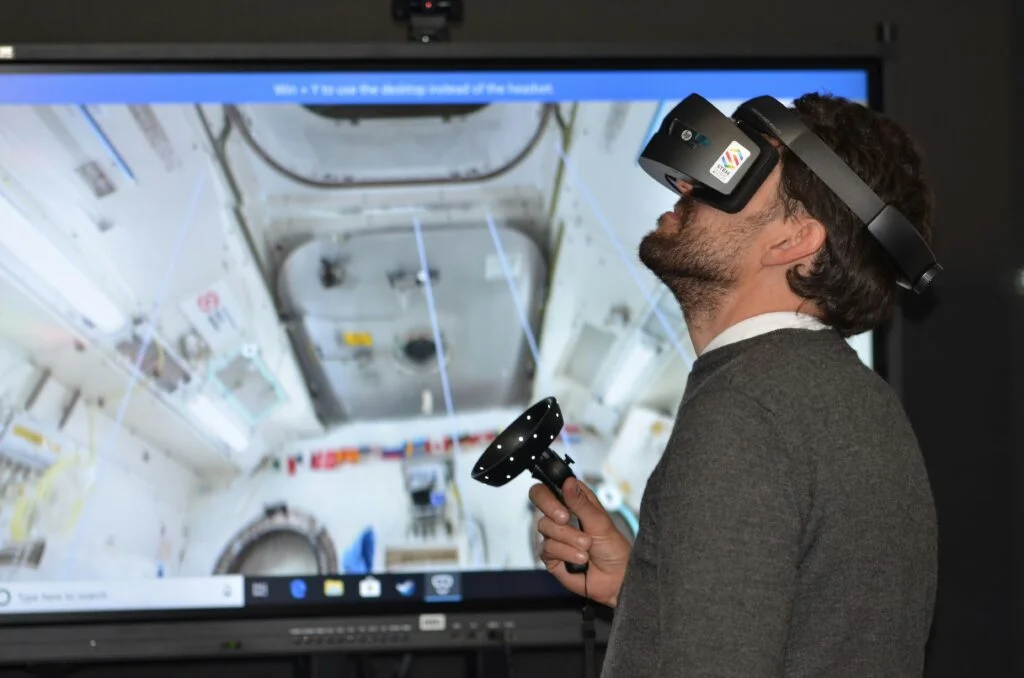Immersion Gone Too Far?
Virtual reality (VR) gaming has significantly evolved over the past few years, transitioning from mere visual and auditory experiences to complex, multi-sensory environments that aim to fully immerse players. One of the latest developments in this field is the integration of physical sensations, including pain, via advanced technologies such as haptic suits, shock gloves, and tension feedback devices. These innovations are designed to create a more realistic experience, allowing players to not only see and hear but also feel the virtual world around them.
The introduction of pain as a component of the gaming experience raises intriguing questions about the nature of immersion in VR. While some argue that incorporating physical sensations can enhance the realism and emotional engagement of a game, others contend that this merger may cross ethical and psychological boundaries. Immersion in VR typically hinges on a player’s ability to suspend disbelief and lose themselves in an alternate reality; however, the addition of pain may serve as a disincentive for engagement, potentially detracting from the intended experience.
Technological advancements make it possible to modulate sensations to ensure that they align with the gameplay narrative, thereby enhancing immersion through controlled discomfort. Haptic suits can simulate impacts or environmental factors such as wind and temperature, whereas shock gloves offer varying degrees of intensity, contributing to a more nuanced experience. Yet, this begs the question: how much immersion is too much? As developers continue to push the limits of what’s feasible in VR, players and industry critics alike are beginning to contemplate the moral implications and long-term effects of such experiences. Is the pursuit of hyper-realistic simulation worth the potential psychological hazards that may arise from experiencing pain within a game setting? This delicate balance between innovation and ethics forms the crux of the ongoing dialogue within the VR community.
The Game That Went Viral
The virtual reality game, known as “Pain Reality,” has rapidly garnered attention in the gaming community due to its immersive yet excruciatingly realistic simulation of physical sensations, including pain. Players don sophisticated VR equipment that transports them into a vividly rendered alternate world, where they navigate through various intriguing scenarios. Each episode within the game is designed to challenge players not only physically but also emotionally, evoking an adrenaline rush that can only be felt in a realistic setting.
One of the game’s primary features is its dynamic gameplay mechanics that adapt to the player’s responses, thereby enhancing the experience of discomfort. When players encounter hazards, they feel authentic sensations that mimic real-life pain—be it a light sting or a jarring shock. This unique design element has led to discussions about the thresholds of pain tolerance and the psychological aspects of fear in gaming. Furthermore, the storyline interweaves concepts of resilience and survival, prompting gamers to explore their own limits as they progress through the levels, facing increasingly daunting challenges.
“Pain Reality” distinguishes itself from other VR games not only through its focus on pain but also via its engagement with the player’s psyche. With each virtual encounter, players have reported an exhilarating blend of fear and fascination, making them crave the intense experience. The game’s virality is further amplified by streamers and content creators who broadcast their gameplay live, sharing their reactions and showcasing their experiences to captivated audiences. These viral moments have not only boosted the game’s popularity but have also sparked debates about the ethics and implications of virtual pain in gaming. As the game continues to climb in rankings, its unique premise captures the intrigue of those curious about the limits of virtual experiences.
What Happens in It?
This innovative VR game offers players an extraordinary and controversial experience that explores the boundaries between virtual reality and physical sensations. As users don their VR headsets and enter the game, they find themselves in a meticulously crafted environment that replicates real-world scenarios. The objective is not just to navigate through challenges but to confront a series of intense experiences designed to elicit strong emotional and physical reactions.
One of the key elements of gameplay involves a variety of challenges that require players to complete tasks while facing obstacles that can provoke discomfort or pain. These challenges are carefully designed to create a sense of urgency as players must make quick decisions. The immersive environment adds to this urgency, as the surrounding sound design and visual aesthetics aim to fully engage the senses, making players feel as though they are genuinely part of the experience.
The game also includes interactive elements that engage players directly with the environment. For example, players might be tasked with retrieving an object while simultaneously dodging obstacles that simulate physical pain, such as simulated hits or falls. These interactions heighten the intensity of the gameplay, increasing the psychological stakes involved. Players often report experiencing heightened states of adrenaline, fear, and even anxiety, as they are thrust into scenarios that can feel overwhelmingly real.
Pain components are uniquely integrated into the gameplay, as certain actions can lead to virtual repercussions that players perceive as discomforting. This deliberate design choice raises numerous ethical questions about the implications of mixing gaming with pain. Nevertheless, it has captivated a niche audience willing to pay for the opportunity to explore these unprecedented sensations. This merging of entertainment, psychological engagement, and physical response challenges traditional notions of gaming and highlights a transformative shift in the gaming landscape.
Why Streamers Are Screaming
The emergence of pain-inducing virtual reality (VR) games has captured the attention of streamers and gamers alike. This unique genre invites players to engage with immersive, often excruciating experiences that elicit visceral reactions. As streamers broadcast their gameplay live, audiences witness a captivating interplay between entertainment and anticipation. The intense emotional and physical responses from streamers not only amuse viewers but also create a sense of shared experience that enhances viewer engagement.
In countless streaming sessions, notable moments have unfolded, capturing both the hilarity and horror of virtual pain. Streamers, often equipped with VR headsets and haptic feedback devices, react to in-game scenarios that induce simulated pain, triggering a spectrum of emotional responses. Viewers can be seen laughing at the exaggerated reactions, while others express empathy for the streamer’s plight. This duality fuels a community of shared experiences and interactions that amplify the game’s popularity.
Streamers have utilized various tactics to boost audience engagement, such as polls, comments, and interactive challenges related to the painful aspects of gameplay. This active participation transforms spectators into participants, fostering a sense of connection and community around the content. As gamers navigate dangerously thrilling scenarios, each scream and laugh transcends mere gameplay, morphing into an entertainment spectacle. The power of the streamer’s reactions to the game’s challenges results in memorable moments that viewers eagerly share across social media, further establishing a viral momentum.
The combination of fear, humor, and the unknown captivates audiences, ensuring that these VR games maintain their place in the streaming world. As audiences continue to engage with these unique experiences, the pain threshold of streamers invites intrigue, laughter, and a sense of camaraderie that few other forms of entertainment can replicate. This blending of gaming with real-time reactions proves that, in the domain of streaming, even pain can be a source of entertainment.
Should This Be Legal?
The emergence of virtual reality (VR) has revolutionized the gaming industry, creating immersive experiences that blur the lines between digital fantasies and reality. However, the introduction of VR games designed to evoke pain or discomfort raises pressing ethical and legal questions. Are we venturing into potentially harmful territory with games that aim not only to challenge players’ skills but also their physical and emotional thresholds? This query invites a spectrum of opinions from experts in gaming ethics, psychology, and VR technology.
From an ethical standpoint, it is crucial to evaluate whether players are adequately informed about the potential risks associated with these experiences. Unlike traditional games, where discomfort may stem from the in-game environment or challenges, VR experiences that deliberately cause pain could cross ethical boundaries by subjecting players to real-life physical sensations. The risk of injury or psychological distress is a legitimate concern, and it forces us to explore the realm of informed consent. Are players truly capable of understanding the implications of engaging with such content?
Legal implications also arise when considering virtual reality games that incorporate pain. Current regulations regarding video games generally focus on age restrictions and content warnings, but these might not encompass the nuances of harmful experiences within immersive environments. Legislators may need to consider introducing new frameworks that specifically address VR technologies, aiming to protect consumers from potential risks associated with games that include pain as a core component.
Furthermore, research into the psychological effects of pain-infused VR experiences is necessary. Insights from mental health professionals could illuminate the long-term ramifications of engaging with such content, providing a clearer understanding of the potential for desensitization or adverse mental health effects. As we navigate this emerging landscape, it becomes imperative to engage in open discourse about the ethical and legal standing of VR games focused on pain, ensuring that regulatory measures uphold player safety without stifling innovation in the gaming sector.
Risk vs. Reward
The emergence of virtual reality (VR) games that simulate pain has sparked a compelling dialogue about the balance between thrill-seeking and potential danger. Players often engage in these intense experiences seeking the adrenaline rush that is frequently described as a powerful draw. However, the immersive nature of VR can lead to unforeseen risks that warrant careful examination.
When players enter a VR environment designed to simulate pain, they depart from their physical surroundings and immerse themselves in a realm where danger feels authentic. This discrepancy between reality and virtuality can heighten emotional responses and sometimes lead to a psychological phenomenon known as “embodiment,” where players perceive the virtual pain as real. Studies have indicated that high levels of emotional and physical arousal during gameplay can result in undesirable outcomes, including anxiety or trauma, particularly for those predisposed to such reactions.
Moreover, the physical aspect of VR gaming introduces risks of injury. Statistics suggest that approximately 15% of users have reported experiencing physical injuries while playing VR games, ranging from minor bruises to more serious conditions. These incidents often occur due to the immersive nature of the games, causing players to lose awareness of their surroundings. Such risks are compounded in games that simulate pain, as they push physical and mental limits.
Nevertheless, proponents argue that the thrill of virtual pain experiences can lead to personal growth, as players confront their fears or limitations. The potential for catharsis in this controlled environment cannot be overlooked, as individuals might learn resilience and develop a deeper understanding of their pain thresholds. Ultimately, the decision to engage in these VR experiences requires a careful consideration of both the exhilarating rewards and the inherent risks, shaping a broader dialogue on risk-taking behaviors in gaming culture.
Physical Consequences
The emergence of virtual reality (VR) gaming, particularly those utilizing haptic technology that simulates pain, raises significant concerns regarding the physical implications for players. As VR immerses users in a simulated environment, the incorporation of painful stimuli can elicit genuine physiological responses. This occurs because the human brain often reflects real-world reactions to simulated experiences, blurring the lines between reality and virtuality. Upon encountering these painful stimuli, players may experience heightened heart rates, increased adrenaline levels, and even muscle tension as the body responds instinctively to perceived threats.
Moreover, ongoing engagements with these VR experiences can lead to potential injuries. For instance, repeated exposure to intense pain simulations may result in aches or strains due to sudden movements or reflexive actions taken by the player. Furthermore, prolonged sessions in VR environments can lead to physical fatigue and discomfort, as the body remains engaged for extended periods without adequate rest. Health professionals express concern over the long-term effects of engaging with such technology regularly. Among these concerns are the risks of developing desensitization to pain, which may alter an individual’s pain threshold and influence their real-life reactions to pain, potentially resulting in risky behaviors.
To mitigate these risks, awareness and precaution are paramount. Players must recognize their limits and be attentive to the physical sensations experienced during gameplay. Recommendations from health experts advocate for breaks during sessions, hydration, and an understanding of the signs that indicate physical strain. Engaging in VR gaming that simulates pain should be approached with caution, paying close attention to the body’s signals, thereby ensuring that the immersive experience does not compromise physical well-being.
Emotional Consequences
The experience of pain in a virtual reality (VR) setting can evoke significant psychological and emotional responses among players. Engaging with virtual pain not only challenges players’ perceptions of danger but also brings forth deep-seated fears, stress, and anxiety, which can lead to a range of emotional consequences. Some players report feeling a heightened sense of adrenaline or alertness during gameplay, while others may experience acute discomfort that lingers even after the game has concluded.
One significant aspect to consider is how players cope with the fear induced by virtual pain. For some, the thrill of confronting fear can lead to a sense of achievement and empowerment; overcoming these virtual challenges can bolster self-esteem and resilience. However, for others, the experience can exacerbate pre-existing anxiety disorders, leading to increased stress levels and a diminished quality of life. This divergence in responses can heavily influence players’ emotional well-being, creating a need for self-awareness regarding their limits and mental health.
<pmoreover, a="" actual="" also="" alter="" an="" and="" as="" begin="" both="" can="" controlled="" could="" desensitization="" desensitization.="" detachment="" diminish,="" effectively="" effects.="" emotional="" empathy="" environment="" experiences="" experiencing="" exposure="" fear="" feelings,="" find="" frequent="" from="" genuine="" have="" health="" help="" in="" individuals="" insights="" it="" lead="" manage="" may="" mental="" more="" negative="" of="" others="" p="" pain="" pain.="" pain.
As the technology behind VR continues to advance, understanding the emotional consequences of such experiences becomes increasingly vital. Players and developers alike must remain cognizant of the impact that simulated pain can have on mental health, ensuring that the immersive nature of VR remains a safe and enriching experience.
The Future of VR Gaming
The landscape of virtual reality (VR) gaming is poised for transformative changes as developers explore the incorporation of intense sensations, including pain. This evolution signifies a paradigm shift from traditional gaming, focusing on immersive experiences that engage players on a multi-sensory level. With advancements in haptic technology, we can expect a future where gamers will not only observe and interact with virtual worlds but also feel them in ways previously thought unattainable.
Developers are already experimenting with devices that provide realistic tactile feedback, immersing players deeper into the game environment. These advancements might pave the way for more nuanced experiences, where sensations such as heat, cold, and, intriguingly, pain are utilized to enhance emotional engagement and realism. While the concept of experiencing pain in gaming might raise ethical questions, it also opens up opportunities for innovative gameplay mechanics that could reshape how stories are told in this medium.
The ongoing integration of artificial intelligence (AI) into VR games may also lead to highly personalized experiences, tailoring the intensity and nature of sensations based on individual player responses. As gamers increasingly seek deeper immersion, studios are likely to invest in technology that amplifies these sensory experiences. The challenge will be to balance enjoyment with discomfort, ensuring that the sensation of pain is purposeful and enhances the narrative rather than detracts from player engagement.
Looking ahead, gamers themselves will play a crucial role in shaping the future of VR gaming. As their expectations evolve, developers must stay attuned to desires for realism, interactivity, and emotional depth. Whether it’s more immersive storytelling or the exploration of moral dilemmas through heightened sensory experiences, the next generation of VR games appears not only promising but holds the potential to redefine entertainment as we know it. The gaming industry is poised at the brink of a new frontier, and the possibilities are genuinely boundless.

It could cover a range of topics related to health, wellness, beauty, personal growth, and social issues, all from the perspective of striving for beauty, intelligence, youthfulness, and impartiality





